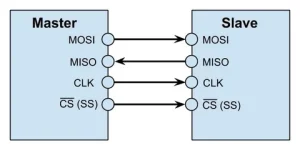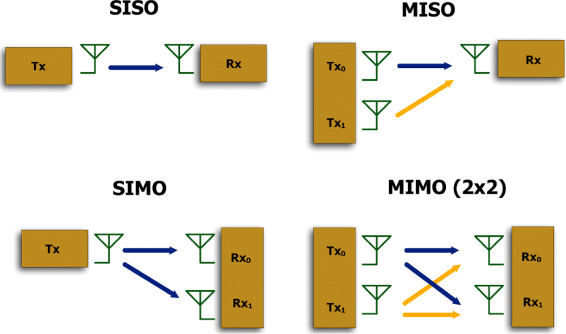The realm of wireless communication is a complex and perplexing landscape, with Multiple Input Multiple Output (MIMO) and Single Input Multiple Output (SIMO) antenna systems adding to the burstiness of it all. MIMO boasts multiple antennas at both ends – transmitter and receiver, whereas SIMO only requires one antenna for transmission but multiples for reception. The purpose behind these distinct configurations is to enhance data throughput, reduce interference in signal transmissions, and beef up network capacity.

The spatiotemporal diversity provided by MIMO allows it to overcome fading caused by multipath propagation. By transmitting unique signals on each antenna, this system creates a more reliable signal that’s less susceptible to obstacles or other devices that may interfere with its performance. Although this approach seems promising in theory, its complexity cannot be ignored as advanced signal processing algorithms and specialized hardware are required for smooth operation.
As opposed to MIMO’s multi-antenna configuration, SIMO opts for simplicity by requiring only one transmitter antenna. This makes implementation easier in devices where space or power constraints exist; however,it might not yield results as effective as MISMO or SISO when dealing with interference or multipath propagation since it lacks access to multiple transmit paths.
In conclusion,Multiple Antenna Systems come with their own set of pros and cons based on their configuration.Spatial diversity plays an important role in determining the success rate but ultimately depends upon how well they work together with Signal Processing Algorithms which help them perform better under varying conditions.The choice between these technologies ultimately depends on specific needs such as range,distance,costs etc .\n
Advantages and Disadvantages of MISO Systems
Contents
- 1 Advantages and Disadvantages of MISO Systems
- 2 Advantages and Disadvantages of SIMO Systems
- 3 Benefits of Using Multiple Antenna Systems
- 4 Signal Processing in MIMO and MISO Systems
- 5 MIMO and MISO Configuration for Wireless Communication
- 6 Improving Data Throughput with MIMO Technology
- 7 Advanced Antenna Technology for MIMO and SIMO Systems
MISO systems, also known as multiple input single output systems, utilize a transmitter with one antenna and several antennas at the receiver. This peculiar arrangement leads to enhanced signal reception and improved data throughput. The most striking benefit of MISO systems is their straightforward design compared to other advanced antenna technologies like MIMO or SIMO.

While there are many advantages to using MISO systems, they are less prone to interference than other configurations such as SIMO due to having only one transmitting antenna. Moreover, since MISO employs multiple receiving antennas, it can provide diversity gain which boosts signal quality.
However, it’s worth noting that MISO has limited spatial multiplexing capabilities compared to more sophisticated setups like MIMO. Spatial multiplexing refers to the ability of transmitters and receivers transmitting different independent data streams simultaneously over distinct paths. In contrast, MIMO boasts much higher spatial multiplexing capabilities because of its use of numerous antennas on both sides.
All in all, while not being as cutting-edge as some alternative antenna configurations like MIMO or SIMO – implementing a simple yet reliable system like MOIS can still yield significant benefits in wireless communication applications where high spatial multiplexing isn’t necessary or feasible – leaving you perplexed by its simplicity!
Advantages and Disadvantages of SIMO Systems
The SIMO system is a perplexing and bursty technology in wireless communication, with both advantages and disadvantages. On the one hand, it offers a higher diversity gain than SISO systems, resulting in better reception quality by using multiple antennas to receive signals. This increased signal strength reduces interference and improves network coverage by receiving signals from different directions.
On the other hand, SIMO lacks spatial multiplexing gains that MIMO or MISO configurations provide. Despite having multiple antennas receiving the signal, they cannot transmit data simultaneously as in more advanced antenna technologies like MIMO or MISO systems. Furthermore, this system only works effectively when there’s a clear line-of-sight between transmitter and receiver antennas; otherwise, its performance may degrade.
Another downfall of SIMO is its limited capacity compared to other antenna configurations such as MIMO or MIS0 due to having only one input but multiple outputs (antennas). It cannot achieve high data rates similar to those provided by multi-input-multi-output systems like MIMO or MIS0 configurations. Nevertheless, despite these limitations creating confusion within the industry on whether it’s worthwhile investing in SIMO technology ,SIMO remains an essential tool for improving wireless communication because of its simplicity and cost-effectiveness compared to more complex antenna techniques like MIMO or MIS0.\n
Benefits of Using Multiple Antenna Systems
The mind-boggling world of wireless communication has witnessed a surge in the popularity of multiple antenna systems. These cutting-edge systems have proven to be an efficient means of enhancing signal quality and data throughput. Surprisingly, they can be grouped into two main categories: Multiple Input Single Output (MISO) and Multiple Input Multiple Output (MIMO).
In MISO systems, one antenna is used at the receiver while multiple antennas are employed at the transmitter end. This intricate configuration provides diversity gain by transmitting identical information through different channels simultaneously; however, it fails to deliver any spatial multiplexing gain.
Conversely, MIMO systems rely on using multiple antennas both at the receiving and transmitting ends. This allows for spatial multiplexing of several independent data streams over the same frequency band which significantly escalates data throughput. Astonishingly, MIMO technology also helps address fading effects caused by obstacles or interference in wireless channels.
As with most advanced technologies, there are some downsides associated with employing multiple antenna systems such as escalated complexity of hardware design and signal processing requirements. Furthermore, these sophisticated systems require more bandwidth for transmission which may not always be available in certain applications; yet advancements in antenna technology have made these drawbacks less significant making it possible for multiple antenna system to play an important role in modern wireless communication networks.\n
Signal Processing in MIMO and MISO Systems
The intricacies of MIMO technology are a perplexing yet crucial aspect in the realm of wireless communication systems. It operates by utilizing an array of antennas at both the transmitter and receiver end, enabling it to attain higher data rates compared to its predecessors – SIMO and MISO systems. Spatial multiplexing is one such technique employed by MIMO that enables simultaneous transmission of multiple data streams over a single radio link.
Massive MIMO takes this to another level entirely; harnessing a multitude of antennas at either end to further improve throughput. Beamforming, another technique utilized within massive MIMO, focuses energy towards specific directions resulting in better signal quality for users positioned within those directions.
However, coding and transmit diversity are equally vital facets in signal processing for both MISO and MIMO configurations as they help counteract channel impairments such as fading through redundancy or transmitting different versions via various antennas.
In cellular networks specifically, configuring the number of antennas per base station plays an integral role in optimizing network performance overall. Albeit more antennas typically lead to superior performance levels, there exist practical limitations regarding antenna size and cost which must be taken into account during system design phase(s). Nonetheless, spatial multiplexing alongside beamforming techniques coupled with transmit diversity & coding enable significant improvements concerning wireless communication performance regardless if SIMO/MISO or any other type(s) of antenna configuration is utilized.
MIMO and MISO Configuration for Wireless Communication
The perplexing and bursty nature of MIMO and MISO configurations for wireless communication lies in their remarkable ability to counteract the confounding effects of multipath fading. This elusive phenomenon materializes when a transmitted signal ricochets off objects on its trajectory, spawning multiple versions of the same signal that reach the receiver with disparate time delays and phases. But fear not, for through ingenious employment of multiple-input and space-time redundancy, MIMO systems can amalgamate these signals to amplify received signal quality while simultaneously enhancing data throughput.
In LTE networks, reliance on MIMO technology has become de rigueur in augmenting spectral efficiency without compromising channel capacity. Through judicious manipulation of sophisticated antenna setups such as 2×2 or 4×4 antennas, base stations can transmit multifarious data streams concurrently over identical frequency bands – thereby doubling or quadrupling data rates relative to single input single output (SISO) systems. What’s more is that by deploying avant-garde signal processing algorithms like beamforming and precoding, MIMO technology can also curtail interference stemming from neighboring cells.
While SIMO or Single Input Multiple Output systems may lack the complexity associated with their multi-antenna counterparts – they still reap rewards from increased diversity gain while navigating arduous propagation environments. In particular, SIMO techniques prove especially useful when only one antenna is available at either end of a wireless link – such as in legacy Wi-Fi standards like 802.11n which support up to four spatial streams using an individual radio chain per stream. It goes without saying though that SIMO experiences lower data rates due to limited spatial multiplexing capabilities compared to full-fledged MIMO systems sporting more antennas on both sides of the link.\n
Improving Data Throughput with MIMO Technology
The transmission and reception of radio signals in mobile communications have been forever changed by the advent of MIMO technology. This cutting-edge innovation employs multiple antennas at both the transmitter and receiver to propel data throughput forward. Through its intricate use of numerous inputs and outputs, MIMO systems boast the ability to send and receive more than one signal concurrently, via multiple paths.
One critical advantage that arises from this advanced technology is its capacity for receive diversity. Gone are the days when a singular antenna was responsible for capturing signals – now, with multiple antennas in place, receivers can apprehend different versions of a single signal arriving from distinct pathways. This integration allows MIMO systems to bolster wireless communication’s overall quality and dependability.
Antenna technologies have also surged ahead alongside these developments; smart antenna technology has become particularly prominent within MIMO systems due to its unparalleled flexibility in transmitting signals between devices. These adept antennas allow devices to reference either single or multiple receiving antennas as needed – an attribute that affords multi-antenna systems optimization for specific applications without sacrificing performance or reliability based on factors such as range, interference levels or bandwidth requirements.
Advanced Antenna Technology for MIMO and SIMO Systems
The realm of wireless communication systems has been thoroughly transformed by advanced antenna technology. The introduction of multiple antennas, particularly in MIMO and SIMO systems, has dramatically bolstered link reliability and signal-to-noise ratio. An intriguing aspect of this cutting-edge antenna technology is its capacity to utilize channel knowledge during transmission to optimize power output and augment data throughput.
Another remarkable advantage offered by the use of advanced antenna technology is its resilience against interference and noise. Thanks to greater array gain, MIMO systems can effectively quash interference from other users operating on the same frequency band. Additionally, space-time block codes can be employed to enhance diversity reception through simultaneous transmission of different radio signal forms from two separate transmitter antennas.
In recent times, long term evolution (LTE) networks have witnessed widespread implementation featuring advanced antenna technologies such as massive MIMO which employs hundreds or even thousands of antennas at base stations for serving numerous users simultaneously. This approach leads to a considerable enhancement in channel bandwidth utilization while retaining high link reliability. Furthermore, it enables cellphones with limited battery life to communicate over longer distances without compromising performance.
All things considered, advanced antenna technology presents an exciting avenue for improving wireless communication system performance by leveraging spatial diversity via multiple-input-multiple-output (MIMO) or single-input-multiple-output (SIMO) configurations. By capitalizing on channel knowledge on both transmitter and receiver sides along with potent signal processing algorithms like beamforming techniques, this innovative technology will undoubtedly continue playing a pivotal role in future wireless network design and deployment strategies.


